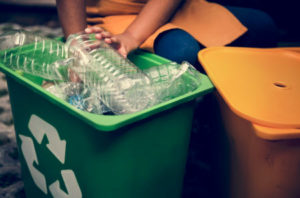Many common building materials, such as paint and carpeting, emit chemicals during and after installation, which can compromise indoor air quality. According to the US Environmental Protection Agency (USEPA), most people receive 72 percent of their exposure to potentially hazardous air pollutants at home – the one place where most of us feel the safest.
Some of the substances being released into home or office buildings include organic chemicals such as formaldehyde, benzene, acetaldehyde, and toluene, which are referred to as Volatile Organic Compounds (VOC) because they off-gas readily into the air.
VOCs are the most common contaminant of indoor air, with concentrations up to 10 times higher indoors than outdoors, according to the EPA. In fact, most of our exposure to environmental pollutants takes place when we breathe indoor air, which can be 2 to 5 times more polluted than the outdoor air. This is a significant concern, because people spend the vast majority of their time indoors, where they are exposed to indoor air pollutants as they sleep, work, or go to school.
So how do VOCs get into our homes? Most of the VOCs that we are exposed to on a daily basis are commonly found in manufactured wood products such as composites; flooring and carpeting; ceiling, wall, thermal and acoustic insulation; interior paints; interior adhesives and sealants; and furniture and upholstery.
The largest concentration of VOCs is typically released when a product is first installed, with emissions diminishing over time. Products that are applied wet, such as adhesives and paints, usually release large quantities of VOCs during the first few days or weeks after application. After that, the emissions taper off quickly. On the other hand, solid materials such as wood products, furniture, or flooring may have relatively low initial VOC emissions, but because it takes longer for these emissions to taper off, they may contribute to long-term air quality issues.
Health Effects
VOCs are associated with a range of health effects. Short-term exposure to VOCs can result in “Sick Building Syndrome,” with large groups of building occupants reporting symptoms such as eye, nose and throat irritation, headaches, and dizziness. Longer term exposure – referred to as “Building Related Illnesses” – can result in nervous system, kidney and liver damage, and can lead to cancer. Children, seniors, and people with respiratory problems are at particular risk of a serious reaction from exposure to VOCs. In some cases, exposure to VOCs may trigger “Multiple Chemical Sensitivity,” stimulating higher sensitivity to other chemicals.
VOCs can also react with nitrogen oxides (NOx) in sunlight to create ozone, which can cause eye and bronchial irritation. This has prompted the initiation of regulatory restrictions of VOCs. The EPA regulates VOCs in air, water, and land, while the Safe Water Drinking Act sets maximum contaminant level standards for several organic compounds in public water systems. Although OSHA regulates VOC exposure in the workplace, VOC exposure is not regulated in non-industrial indoor air.
Steps to Improve Indoor Air Quality
A clearer understanding of the health impacts of these chemicals combined with more sophisticated testing technologies has led to more stringent health-based standards to screen materials based on their effect on indoor environmental quality. In addition, product certification programs such as GREENGUARD and Indoor Advantage, as well as industry specific certification programs are having a significant impact on improving indoor air quality.
As concerns both with air quality and with the health risks associated with these chemicals has grown, the demand for low-VOC and No-VOC products has dramatically increased. Low-emitting products are now widely available, making it easier for architects, designers and facilities managers to specify healthier, more sustainable products and materials for their projects.
Considerations in Selecting Building Products and Materials
Because we spend so much of our time indoors, our health depends on improving the quality of indoor air. According to the USEPA, the best strategy to limit chemical exposure and reduce indoor air pollution is source control. This includes selecting products such as GREENGUARD Certified products that have been tested and certified for low chemical emissions. GREENGUARD Certified products are tested for more than 10,000 chemicals to ensure their safe use indoors, and these products are listed on the free UL SPOT database.
Low emitting products and materials offer multiple benefits:
- They do not release significant pollutants into the indoor environment.
- They reduce the symptoms of sick building syndrome, including headaches, fatigue, eye and respiratory irritation, dizziness, and other symptoms.
- They reduce pollution of natural waterways.
- And they improve worker safety and health.
When selecting building products and materials, architects, designers, facilities managers, and builders, have an opportunity to choose products and materials that can enhance air quality, improve human health, and protect the environment. Selecting low emission products and materials can also help projects achieve LEED credits, an important consideration in the design and construction of sustainable structures.
LEED lists seven different categories for interior and exterior features to achieve compliance for certification pertaining to VOC. These categories include:
- Interior Paints
- Interior adhesives and sealants
- Flooring
- Composite wood
- Ceilings, walls, thermal and acoustic insulation
- Furniture
To achieve LEED credit, products such as adhesives, sealants, interior paints, and furniture must reach a threshold of 90% low-VOC.
In addition to achieving VOC compliance, a sustainably designed building will incorporate products and materials, which can be reused or recycled upon the end of the product’s life, or the life of the building, reducing the amount of waste that enters landfills.
Supporting a Healthier Environment
At Scranton Products, we believe in supporting a healthier environment. As a leading manufacturer of toilet partitions, lockers and other HDPE (high density polyethylene) products, Scranton Products adheres to the highest standards, developing low emitting products that meet LEED requirements for air quality and sustainability, as well as meeting GREENGUARD emissions standards.
Our products are free of VOC emissions, are eligible for LEED credits pertaining to VOCs, and are GREENGUARD Gold Certified, meeting strict certification requirements for use in schools and healthcare facilities. In addition, all of our products are made from recycled materials and are 100% recyclable.
By selecting low emitting products made with Scranton Products HDPE, architects, designers, facilities managers, and builders can help to improve the indoor air quality of their projects while reducing environmental impact.
For more information on Scranton Products low-emitting, sustainable products, click on the link below.



 When recycled, HDPE is generally separated by grade since some HDPE plastic is thicker and more durable than others. All the plastic is rigorously cleaned to remove any particles or debris, so only the HDPE materials can be homogenized and processed. By removing any foreign debris and cleaning the plastic, HDPE is safe to continue with its recycling. Any particles left in will essentially ruin the end products.
When recycled, HDPE is generally separated by grade since some HDPE plastic is thicker and more durable than others. All the plastic is rigorously cleaned to remove any particles or debris, so only the HDPE materials can be homogenized and processed. By removing any foreign debris and cleaning the plastic, HDPE is safe to continue with its recycling. Any particles left in will essentially ruin the end products.